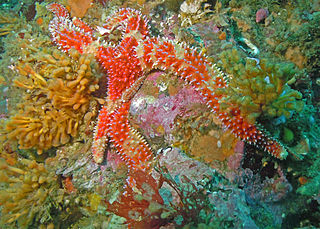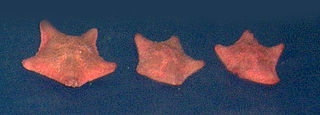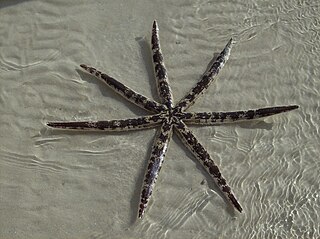
An echinoderm is any member of the phylum Echinodermata. The adults are recognisable by their radial symmetry, and include starfish, brittle stars, sea urchins, sand dollars, and sea cucumbers, as well as the sea lilies or "stone lilies". Adult echinoderms are found on the sea bed at every ocean depth, from the intertidal zone to the abyssal zone. The phylum contains about 7,000 living species, making it the second-largest grouping of deuterostomes, after the chordates. Echinoderms are the largest entirely marine phylum. The first definitive echinoderms appeared near the start of the Cambrian.

Starfish or sea stars are star-shaped echinoderms belonging to the class Asteroidea. Common usage frequently finds these names being also applied to ophiuroids, which are correctly referred to as brittle stars or basket stars. Starfish are also known as asteroids due to being in the class Asteroidea. About 1,900 species of starfish live on the seabed in all the world's oceans, from warm, tropical zones to frigid, polar regions. They are found from the intertidal zone down to abyssal depths, at 6,000 m (20,000 ft) below the surface.

Tube feet are small active tubular projections on the oral face of an echinoderm, whether the arms of a starfish, or the undersides of sea urchins, sand dollars and sea cucumbers; they are more discreet though present on brittle stars, and have only a feeding function in feather stars. They are part of the water vascular system.

Intertidal ecology is the study of intertidal ecosystems, where organisms live between the low and high tide lines. At low tide, the intertidal is exposed whereas at high tide, the intertidal is underwater. Intertidal ecologists therefore study the interactions between intertidal organisms and their environment, as well as between different species of intertidal organisms within a particular intertidal community. The most important environmental and species interactions may vary based on the type of intertidal community being studied, the broadest of classifications being based on substrates—rocky shore and soft bottom communities.

Linckia laevigata is a species of sea star in the shallow waters of tropical Indo-Pacific.

Asterias amurensis, also known as the Northern Pacific seastar and Japanese common starfish, is a seastar found in shallow seas and estuaries, native to the coasts of northern China, Korea, far eastern Russia, Japan, Alaska, the Aleutian Islands and British Columbia in Canada. Two forms are recognised: the nominate and formarobusta from the Strait of Tartary. It mostly preys on large bivalve molluscs, and it is mostly preyed on by other species of starfish. Population booms in Japan can affect the harvest of mariculture operations and are costly to combat.

Mediaster aequalis is a species of sea star in the family Goniasteridae. It is native to the west coast of North America, ranging from Alaska to California. It is found in various habitats including beaches during very low tides, and at depths down to about 500 m (1,600 ft). Also known as the vermilion sea star, it is the type species of the genus Mediaster and was first described in 1857 by the American zoologist William Stimpson.

Asterina phylactica is a species of sea star. It can be found in geographically widespread sites around the British Isles and in the Mediterranean Sea. It has five arms, is about 1.5 cm across and is of a green colour with central brown markings. The species was formally described in 1979 and is very similar to Asterina gibbosa.

Patiria miniata, the bat star, sea bat, webbed star, or broad-disk star, is a species of sea star in the family Asterinidae. It typically has five arms, with the center disk of the animal being much wider than the stubby arms are in length. Although the bat star usually has five arms, it sometimes has as many as nine. Bat stars occur in many colors, including green, purple, red, orange, yellow and brown, either mottled or solid. The bat star gets its name from the webbing between its arms, which is said to resemble a bat's wings.

The leather star is a sea star in the family Asteropseidae found at depths to 100 m (328 ft) off the western seaboard of North America. It was first described to science by Adolph Eduard Grube in 1857.

Ophiocomina nigra, commonly known as the black brittle star or black serpent star, is a species of marine invertebrate in the order Ophiurida. It occurs in the north-eastern Atlantic Ocean, the North Sea, and the Mediterranean Sea.

Linckia multifora is a variously colored starfish in the family Ophidiasteridae that is found in the Indian Ocean and Red Sea. Its common names include the Dalmatian Linckia, mottled Linckia, spotted Linckia, multicolor sea star and multi-pore sea star.
Asexual reproduction in starfish takes place by fission or through autotomy of arms. In fission, the central disc breaks into two pieces and each portion then regenerates the missing parts. In autotomy, an arm is shed with part of the central disc attached, which continues to live independently as a "comet", eventually growing a new set of arms. Although almost all sea stars can regenerate their limbs, only a select few sea star species are able to reproduce in these ways.

The Astropecten articulatus, more commonly known as the Royal Starfish, is a West Atlantic sea star of the family Astropectinidae.

Orthasterias is a genus of sea stars in the family Asteriidae. Orthasterias koehleri, the rainbow star or red-banded sea star, is the only species in the genus. It is found in the North Pacific Ocean.

Asterina gibbosa, commonly known as the starlet cushion star, is a species of starfish in the family Asterinidae. It is native to the northeastern Atlantic Ocean and the Mediterranean Sea.

Luidia maculata is a species of starfish in the family Luidiidae in the order Paxillosida. It is native to the Indo-Pacific region. It is commonly known as the eight-armed sea star because, although the number of arms varies from five to nine, eight arms seems to be the most common.

Echinaster is a well-studied and common genus of starfish containing ~30 species and is the second-largest genus found within the family Echinasteridae. The genera Henricia and Echinaster encompass 90% of all the species found within the family Echinasteridae. It contains 30 species, however the number of species in this genus is still debatable because of uncertainty within the genera. This genus is currently sub-divided into two sub-genera: Echinaster and Othilia, evolutionary relationships between the sub-genera is not understood. Echinaster are found in the Pacific, Atlantic and Indian oceans, with most species being studied in the Gulf of Mexico and Brazil. The sub-genera Othilia is thought to encompass species mainly found in the Gulf of Mexico and Brazil. Echinaster is often one of the most studied species within the family Echinasteridae and is often used to find evolutionary relationships.

Asterina pancerii, commonly known as the seagrass asterina, is a species of starfish in the family Asterinidae. It is native to shallow parts of the Mediterranean Sea where it is usually found in seagrass meadows.
Echinoderm Research and Diversity in Latin America, edited by Juan José Alvarado, Francisco Alonso Solis-Marin Springer Science & Business Media, Aug 7, 2012 - Science
The role of Asterina stellifera (Echinodermata: Asteroidea) as a predator in a rocky intertidal community in southern Brazil. Patrícia Calil, Rosana M. da Rocha, Carolina A. Freire, James J. Roper. Zoologia (Curitiba, Impr.) vol.26 no.2 Curitiba June 2009


















